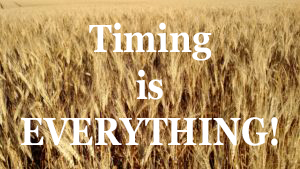Timing is Everything! | Teaching for a Good Harvest
I really want to talk to you about teaching and timing.
I am a farmer’s wife. In farming, timing is everything when it comes to the harvest. If you harvest too soon, the grain won’t be mature or dry enough. The crop will be short or non-existent and what you do manage to harvest will not store well without a great deal of extra effort.
A farmer can do things to ensure that the harvest will be the best it can be: He can plant the seed at the right depth and at the right intervals, He can water, fertilize, and implement pest and disease management procedures, He can cultivate or spray to control weeds, but, he has to look at the crop itself to know when it is time to harvest.
The seed packaging has information about approximately how long it will take for the seed to mature and there are books and charts that can give him a clue as to what to expect, but real-life growing depends on the variables of genetics, temperature, sunshine, and rainfall.
Teaching children is very similar. Our industrialized theories of education tend to have us all up in arms if our children aren’t where the charts say they should be. Educational professionals use words like, “at-risk” and “learning disabled” to identify children who don’t fit the mold. Most of us come out of that type of mindset with a deep sense of ineptitude. Grade levels and milestone charts are a tool to use. That’s all. They don’t take into account your child’s genetics, interests or the fact that he’s got allergies that make it difficult for him to concentrate when the cottonwood trees are blooming.
There are things you can do to help them get ready to read, write and do math. You can read to them, play games that help them develop fine motor and hand-eye coordination, count with them, watch videos and sing songs about letters and numbers, but if you insist that they read or know their multiplication facts by the charts or by what the books say, you can damage your “crop”.
So how do you know when your child is ready? A farmer carefully observes his crop. He looks at the size and the color of the plants. Then, when he thinks it might be ready, he doesn’t just tear in and harvest the whole field. He cuts a little grain. He tests it’s weight and moisture levels. If it’s not quite ready, he waits a little longer. You too, need to observe your child. Is he understanding that letters have sounds? When she colors does she stay in the lines and use realistic colors? Can he count correctly while playing a board game? Does she have a good grasp of addition and subtraction? If so, try the next step. If your child gets frustrated, stop. wait a few days or a week, then try again. You know your child better than anyone else. Trust what you observe. That’s the beauty of homeschooling, you don’t have to stuff your child into the mold.
Fortunately, most kids don’t fall apart if they don’t learn something just as soon as they are ready like farm crops do so don’t worry and don’t push it. They will be far better off in the long run if you just wait until they are ready.
God Bless You All!
~ Grama Sue




Comments
Post a Comment
All comments are moderated to prevent inappropriate content.